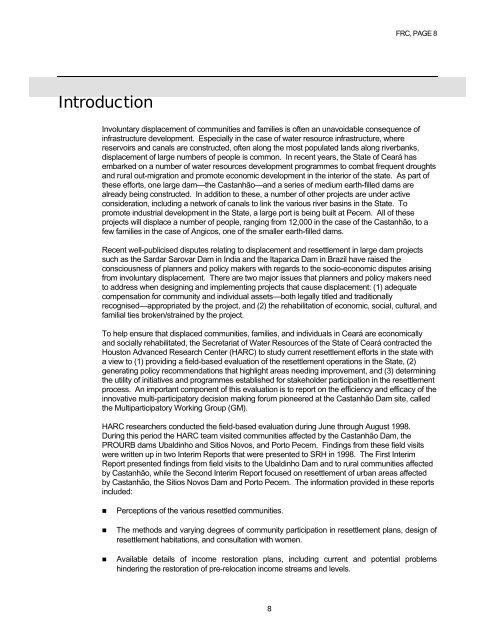Relocation and Resettlement in Ceará - Houston Advanced ...
Relocation and Resettlement in Ceará - Houston Advanced ...
Relocation and Resettlement in Ceará - Houston Advanced ...
You also want an ePaper? Increase the reach of your titles
YUMPU automatically turns print PDFs into web optimized ePapers that Google loves.
Introduction<br />
8<br />
FRC, PAGE 8<br />
Involuntary displacement of communities <strong>and</strong> families is often an unavoidable consequence of<br />
<strong>in</strong>frastructure development. Especially <strong>in</strong> the case of water resource <strong>in</strong>frastructure, where<br />
reservoirs <strong>and</strong> canals are constructed, often along the most populated l<strong>and</strong>s along riverbanks,<br />
displacement of large numbers of people is common. In recent years, the State of <strong>Ceará</strong> has<br />
embarked on a number of water resources development programmes to combat frequent droughts<br />
<strong>and</strong> rural out-migration <strong>and</strong> promote economic development <strong>in</strong> the <strong>in</strong>terior of the state. As part of<br />
these efforts, one large dam—the Castanhão—<strong>and</strong> a series of medium earth-filled dams are<br />
already be<strong>in</strong>g constructed. In addition to these, a number of other projects are under active<br />
consideration, <strong>in</strong>clud<strong>in</strong>g a network of canals to l<strong>in</strong>k the various river bas<strong>in</strong>s <strong>in</strong> the State. To<br />
promote <strong>in</strong>dustrial development <strong>in</strong> the State, a large port is be<strong>in</strong>g built at Pecem. All of these<br />
projects will displace a number of people, rang<strong>in</strong>g from 12,000 <strong>in</strong> the case of the Castanhão, to a<br />
few families <strong>in</strong> the case of Angicos, one of the smaller earth-filled dams.<br />
Recent well-publicised disputes relat<strong>in</strong>g to displacement <strong>and</strong> resettlement <strong>in</strong> large dam projects<br />
such as the Sardar Sarovar Dam <strong>in</strong> India <strong>and</strong> the Itaparica Dam <strong>in</strong> Brazil have raised the<br />
consciousness of planners <strong>and</strong> policy makers with regards to the socio-economic disputes aris<strong>in</strong>g<br />
from <strong>in</strong>voluntary displacement. There are two major issues that planners <strong>and</strong> policy makers need<br />
to address when design<strong>in</strong>g <strong>and</strong> implement<strong>in</strong>g projects that cause displacement: (1) adequate<br />
compensation for community <strong>and</strong> <strong>in</strong>dividual assets—both legally titled <strong>and</strong> traditionally<br />
recognised—appropriated by the project, <strong>and</strong> (2) the rehabilitation of economic, social, cultural, <strong>and</strong><br />
familial ties broken/stra<strong>in</strong>ed by the project.<br />
To help ensure that displaced communities, families, <strong>and</strong> <strong>in</strong>dividuals <strong>in</strong> <strong>Ceará</strong> are economically<br />
<strong>and</strong> socially rehabilitated, the Secretariat of Water Resources of the State of <strong>Ceará</strong> contracted the<br />
<strong>Houston</strong> <strong>Advanced</strong> Research Center (HARC) to study current resettlement efforts <strong>in</strong> the state with<br />
a view to (1) provid<strong>in</strong>g a field-based evaluation of the resettlement operations <strong>in</strong> the State, (2)<br />
generat<strong>in</strong>g policy recommendations that highlight areas need<strong>in</strong>g improvement, <strong>and</strong> (3) determ<strong>in</strong><strong>in</strong>g<br />
the utility of <strong>in</strong>itiatives <strong>and</strong> programmes established for stakeholder participation <strong>in</strong> the resettlement<br />
process. An important component of this evaluation is to report on the efficiency <strong>and</strong> efficacy of the<br />
<strong>in</strong>novative multi-participatory decision mak<strong>in</strong>g forum pioneered at the Castanhão Dam site, called<br />
the Multiparticipatory Work<strong>in</strong>g Group (GM).<br />
HARC researchers conducted the field-based evaluation dur<strong>in</strong>g June through August 1998.<br />
Dur<strong>in</strong>g this period the HARC team visited communities affected by the Castanhão Dam, the<br />
PROURB dams Ubald<strong>in</strong>ho <strong>and</strong> Sitios Novos, <strong>and</strong> Porto Pecem. F<strong>in</strong>d<strong>in</strong>gs from these field visits<br />
were written up <strong>in</strong> two Interim Reports that were presented to SRH <strong>in</strong> 1998. The First Interim<br />
Report presented f<strong>in</strong>d<strong>in</strong>gs from field visits to the Ubald<strong>in</strong>ho Dam <strong>and</strong> to rural communities affected<br />
by Castanhão, while the Second Interim Report focused on resettlement of urban areas affected<br />
by Castanhão, the Sitios Novos Dam <strong>and</strong> Porto Pecem. The <strong>in</strong>formation provided <strong>in</strong> these reports<br />
<strong>in</strong>cluded:<br />
Perceptions of the various resettled communities.<br />
The methods <strong>and</strong> vary<strong>in</strong>g degrees of community participation <strong>in</strong> resettlement plans, design of<br />
resettlement habitations, <strong>and</strong> consultation with women.<br />
Available details of <strong>in</strong>come restoration plans, <strong>in</strong>clud<strong>in</strong>g current <strong>and</strong> potential problems<br />
h<strong>in</strong>der<strong>in</strong>g the restoration of pre-relocation <strong>in</strong>come streams <strong>and</strong> levels.
















